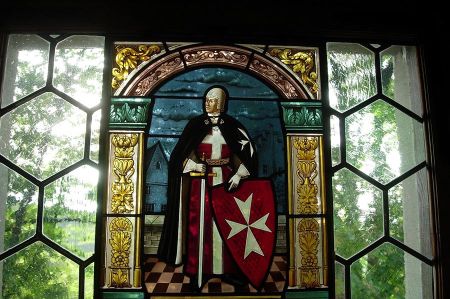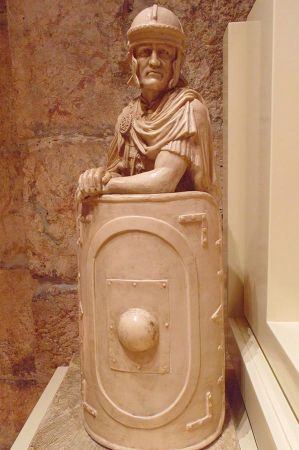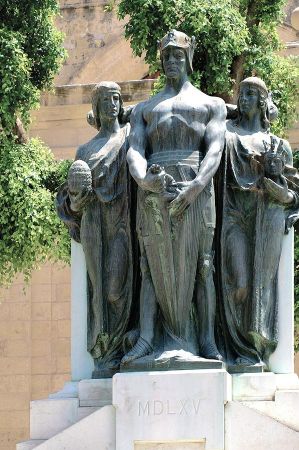Johanniter – from the pilgrim hospital in Jerusalem to Rhodes
- Written by Portal Editor
Long before the First Crusade, merchants from Amalfi had founded a pilgrim hospital in Jerusalem, knowing full well that pilgrims to the holy cities represent an important economic factor (which is still true today),
which is why the protection and care of pilgrims benefitting all those living along the pilgrimage routes in the Mediterranean.
Obligation to pay tithes abolished
 The hospital brotherhood's health care in particular gained a high level of popularity and, in connection with this, the Pope's goodwill. On February 15, 1113, Pope Paschalis II granted the brotherhood the privilege “Pia postulatio voluntatis,” which abolished the obligation to pay tithes and placed the brotherhood directly under papal protection. Even the election of the chairmanship was solely the responsibility of the brotherhood.
The hospital brotherhood's health care in particular gained a high level of popularity and, in connection with this, the Pope's goodwill. On February 15, 1113, Pope Paschalis II granted the brotherhood the privilege “Pia postulatio voluntatis,” which abolished the obligation to pay tithes and placed the brotherhood directly under papal protection. Even the election of the chairmanship was solely the responsibility of the brotherhood.
Four years later, in 1117, the hospital also became independent. The brothers took over the rules of the order from the Augustinians. In the period that followed, noble foundations established stations and hospitals on the pilgrimage routes in many parts of Europe, such as in Bari, Otranto, Taranto, Messina, Pisa, Asti and St. Gilles.
 Under Raimund von Puy (1120–1160), who succeeded the order's founder, Brother Gerhard Tonque, the change from the hospital brotherhood to the spiritual order of knights took place between 1120 and 1140. Around the year 1048, an order arose that was consecrated to John the Baptist, from which the name Johanniter was ultimately derived.
Under Raimund von Puy (1120–1160), who succeeded the order's founder, Brother Gerhard Tonque, the change from the hospital brotherhood to the spiritual order of knights took place between 1120 and 1140. Around the year 1048, an order arose that was consecrated to John the Baptist, from which the name Johanniter was ultimately derived.
However, the pilgrim hospital, also known as Muritan, was still run by monastic brothers who also took care of the sick. With the conquest of Jerusalem by the crusaders of the First Crusade under the command of Godfrey of Bouillon, the brotherhood gained considerably in influence and popularity and was subsequently awarded the “Order of the Hospital of Saint John in Jerusalem” (Latin name: Ordo Hospitalis sancti Johannis Lerosolimitani ) titled.
Impressive evidence of the history of the Order of St. John
 While the order had previously had the goal of serving sick fellow human beings, the order's second mission was to combat “unbelief” and protect pilgrims. As early as 1140, the order was offered several fortresses and Count Raymond II of Tripoli undertook to the order not to make peace without its consent. Imposing evidence of the history of the Order of St. John in the Holy Land is Belvoir Castle in Israel, built in the 12th century, Krak des Chevaliers Castle, which was taken over in 1142, and Margat/Qal'at Marqab Castle in Syria, which came into the possession of the St. John's in 1186.
While the order had previously had the goal of serving sick fellow human beings, the order's second mission was to combat “unbelief” and protect pilgrims. As early as 1140, the order was offered several fortresses and Count Raymond II of Tripoli undertook to the order not to make peace without its consent. Imposing evidence of the history of the Order of St. John in the Holy Land is Belvoir Castle in Israel, built in the 12th century, Krak des Chevaliers Castle, which was taken over in 1142, and Margat/Qal'at Marqab Castle in Syria, which came into the possession of the St. John's in 1186.
With the expansion of privileges such as the “christianae fidei religio” of October 21, 1154, the order was lifted out of episcopal jurisdiction by Pope Anastasius IV and placed directly under the pope. Employees of the order as serving brothers had to take the vow of obedience, members serving as knights or priests also had to take the vows of chastity and poverty, the latter only meaning the renunciation of private property. In 1156, Emperor Frederick I “Barbarossa” confirmed all possessions in the Holy Roman Empire to the order. In 1185 he placed the order under his protection and exempted it from paying all taxes.
 Around 1160, the pilgrim Johannes from Würzburg reported the following events in Jerusalem: “... there is a hospital attached, which collects, cares for and restores a large number of weak and sick people in its various buildings, which means a lot of money.
Around 1160, the pilgrim Johannes from Würzburg reported the following events in Jerusalem: “... there is a hospital attached, which collects, cares for and restores a large number of weak and sick people in its various buildings, which means a lot of money.
During the time I was there myself, as I learned from the serving brothers themselves, the number of sick people was up to twice a thousand. They were so stricken with illness that sometimes more than 50 bodies had to be carried out in a full day.
But over and over again more were added.... Such unmistakable charity developed through the fact that bread was given to the poor who asked for bread, even if they stayed outside the house.
Headquarters of the Order of St. John in Acre
 When Jerusalem fell into the hands of Sultan Saladin in 1187, the headquarters of the Order of St. John was moved to Acre. There, too, the order was able to expand its position of power so much that in 1224 the entire city administration was transferred to it. As a result, the Knights of St. John expanded the city into a fortress, which was largely fortified and reinforced underground.
When Jerusalem fell into the hands of Sultan Saladin in 1187, the headquarters of the Order of St. John was moved to Acre. There, too, the order was able to expand its position of power so much that in 1224 the entire city administration was transferred to it. As a result, the Knights of St. John expanded the city into a fortress, which was largely fortified and reinforced underground.
Now all defense activities in the Holy Land as well as in the Reconquista in Spain were directed from Acre. When Jerusalem had to be finally abandoned on August 23, 1244 and the Battle of Gaza was lost on October 17, 1244, the final withdrawal of the Hospitallers from the Orient began under the leadership of Grand Master Guillaume de Chateauneuf (1242 - 1258).
 The order now consisted mainly of noble knights, priests took over church service, and non-noble lay brothers were also entrusted with nursing care. Raimund, the “chief” of the Hospitallers at the time, still called himself master; the title of grand master was only granted to Hugo von Revel in 1267 by Pope Clement IV.
The order now consisted mainly of noble knights, priests took over church service, and non-noble lay brothers were also entrusted with nursing care. Raimund, the “chief” of the Hospitallers at the time, still called himself master; the title of grand master was only granted to Hugo von Revel in 1267 by Pope Clement IV.
Greatly weakened by constant fighting and losses, in the defence of Acre in 1291, only 800 knights and 14,000 foot soldiers faced the superior force of the Egyptian Mamluks of 66,000 cavalry and 160,000 infantry.
When the fortress fell into the hands of the Mamluks on May 28, 1291, it also meant the loss of the Holy Land for the Crusaders. Limassol on Cyprus was chosen as the new seat of the Order of St. John.
Abolition of the Templar Order
 There followed a phase of disorientation that could not be solved even by two convents in 1292 and 1294. With the request addressed to the Pope to fulfil his duty of supervision over the order, in 1300 William of Villaret could only be persuaded to take up his post as Grand Master at the order's seat in Cyprus through coercion. The former splendour of the Crusades increasingly faded and the opinion spread throughout Europe that the knightly order had not used all the donations appropriately.
There followed a phase of disorientation that could not be solved even by two convents in 1292 and 1294. With the request addressed to the Pope to fulfil his duty of supervision over the order, in 1300 William of Villaret could only be persuaded to take up his post as Grand Master at the order's seat in Cyprus through coercion. The former splendour of the Crusades increasingly faded and the opinion spread throughout Europe that the knightly order had not used all the donations appropriately.
This was particularly evident in the Templar Order, which did not use its influence and power to fight the “enemies of Christianity” as required and was hardly seen in battles. In 1312, Pope Clement V ordered the abolition of the Templar Order and the transfer of the Templars' property to the Hospitallers with the papal bull “Ad providam”. The Hospitallers might have suffered the same fate if Fulko von Villaret had not faced accusations of inaction by conquering Rhodes. By transferring the Templars' possessions to the Knights Hospitaller, they now had additional possessions throughout Europe.
Please also read:
